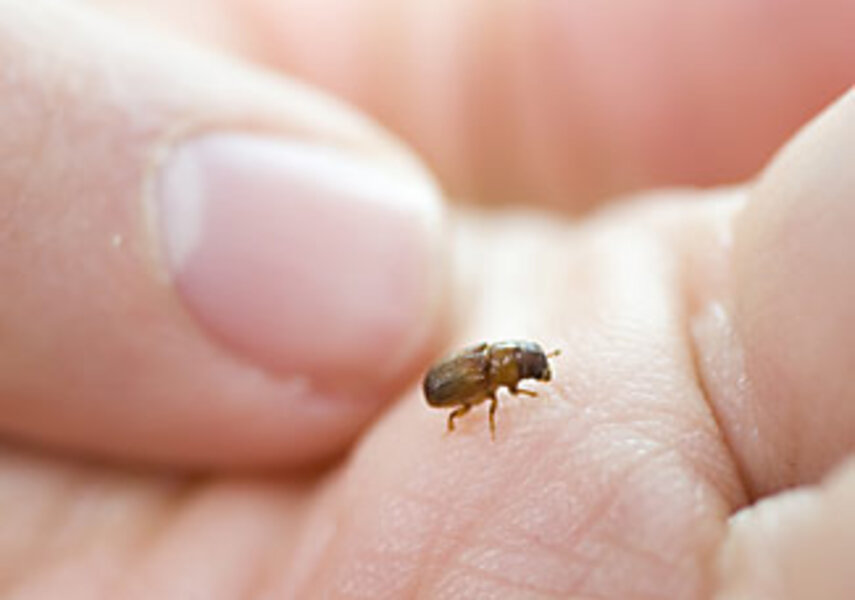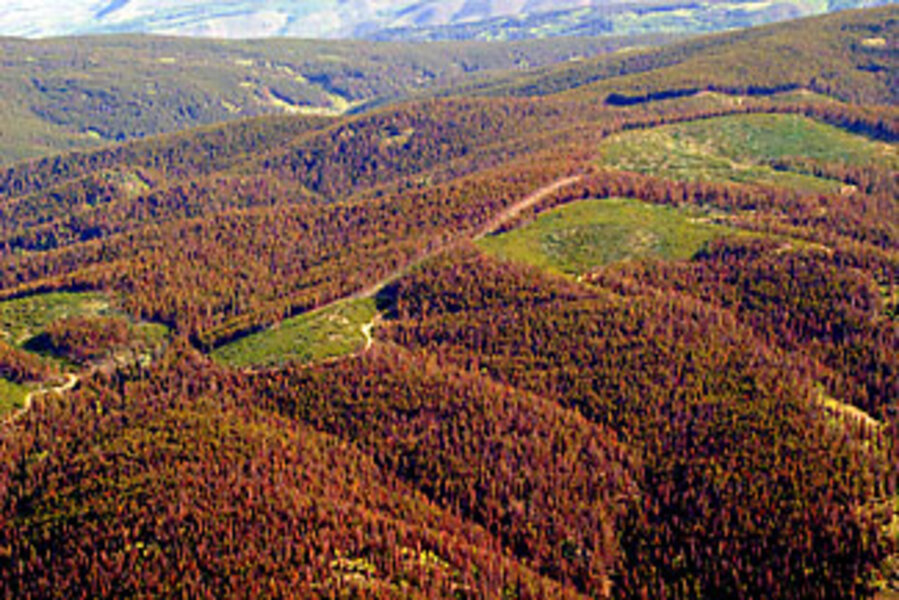In British Columbia, a beetle upsets climate calculus
Loading...
A beetle about the length of a well-trimmed fingernail may be challenging scientists' projections for global warming.
Forests store large amounts of carbon drawn from the atmosphere, helping Earth keep cool. But an infestation of mountain pine beetles is turning more than 144,000 square miles of woods in British Columbia from a slight carbon absorber – or sink – to a net CO2 emitter. Canadian scientists unveiled projections Wednesday that between 2000 and 2020, the forest will have lost 270 million tons of carbon into the atmosphere.
The process has the potential to become a vicious cycle: As the climate warms, it favors more severe outbreaks, and if severe outbreaks increase, that leaves fewer trees to absorb carbon and more emissions as dead trees decompose. Researchers say British Columbia's problem highlights a growing threat that North American forests, too, face from climate change.
"This is very important," acknowledges Tom Veblen, a geographer at the University of Colorado at Boulder who is looking at the interplay of climate change, insect infestations, and wildfires in forests in the western United States. He notes that climate models do not take this type of feedback into account when they gauge temperature trajectories as human-related greenhouse-gas emissions rise.
"It's been known for some time that insects are an important part of the boreal-forest carbon cycle," says Werner Kruz, a scientist at the National Resources Canada's Pacific Forestry Centre in Victoria, British Columbia, who headed the modeling effort. But, he adds, the failure to include bugs' cumulative effect in climate models could be leading researchers to overestimate the amount of human-generated CO2 forests can absorb.
Worst outbreak
British Columbia is deep into its worst infestation of mountain pine beetles on record. Annual emissions from the worst year of infestation come close to matching the average annual emissions from all the forest fires the country experienced between 1959 and 1999, researchers say. Over the 21-year period the projections cover, emissions from the affected forests appear comparable to five years' worth of emissions from Canada's entire transportation sector.
Canada's beetle problem highlights a threat North American forests face from climate change, in addition to wildfires, logging, mining, and other development activities, say researchers. By some estimates, mountain pine beetles and their bark-burrowing cousins infest some 50 million acres of forest, stretching from Alaska to the southwestern US.
And the outbreak highlights the challenges resource managers face as they try to preserve forest resilience in the face of a changing climate and pressure to exploit timber and mineral resources. Because the beetles stay burrowed underneath the bark, the only known method to control infestations before they get out of hand is to cut down the trees they've killed or the live trees they've infected. It's an approach that raises the hackles of some environmentalists and ecologists alike.
Nor is the challenge limited to North America's boreal forests, adds Olga Krankina, a forest ecologist at Oregon State University in Corvallis. Russia has had severe outbreaks of Siberian gypsy moths, which attack foliage.
Historically, the outbreaks have run in cycles, notes Allan Carroll, an entomologist with Natural Resources Canada who was part of the modeling project. The results appear in this week's issue of the journal Nature.
Western North America, where the mountain pine beetles occur naturally, has seen four or five outbursts in the past 100 years. But the current episode represents a perfect storm for British Columbia's forests. Wildfire suppression over the past 60 to 70 years has yielded a forest populated by large numbers of pines 80 to 160 years old – the beetles' habitat of choice. Milder winters and hot, drier summers have helped the beetles thrive.
The exploding bug population found "a real smorgasbord" to support it, Dr. Carroll says.
Spreading east
Those climate factors have also permitted the beetles to move east through mountain passes once too cold for them to clear. And in the summers, significant numbers of the flying beetles have gotten caught up in thunderstorms, which deposit them on the Rockies' eastern slopes.
This migration comes at a time when some 1,500 scientists from around the world are imploring the Canadian government to preserve large swaths of the country's boreal forests. Last May, they sent a letter to the Canadian government asking it to set aside at least half of the forest's 2.3-million-square-mile expanse and keep it free of industrial development, the balance to be managed sustainably.
The bugs' eastward march is likely to be slow, Carroll suggests. And it could further be slowed by the mix of trees east of the Rockies. Stands of jack pine, which the beetles can infest, exist in isolated patches in areas where they've crested the mountains. "The jack pines are not as contiguous as other species, so that would be a barrier," he says.
But control efforts would likely still be needed, he adds. That would mean flying crews into the infested area, cutting down dead and infested trees, and burning them on the spot. The alternative, he says, is watching a "disturbance agent move into a forest that hasn't seen it before ... which could increase the fire risk in the future."
And forest managers are coming around to the idea that it may not be wise to salvage harvest in every circumstance, Dr. Kurz adds. The forest's other benefits, from biodiversity to water and soil conservation, may be better retained from leaving dead trees where they are, especially if they stand along rivers and streams, deep in forests where building access roads would do more ecological harm than the deadfall, or along slopes, where removing trees would lead to serious erosion problems.






